Anxiety and Cognition: Investigating Information Processing in Adults
VerifiedAdded on 2021/05/30
|39
|8262
|18
Report
AI Summary
This research report investigates the impact of sub-clinical anxiety levels on information processing speed and intra-individual variability in younger and older adults. Using a visual search research method, the study examines factors such as gender, age, anxiety levels, vision, handedness, subjective memory function, and objective cognitive function. It builds upon previous studies, exploring the effects of these factors on information processing, and addresses research questions related to the relationship between age and cognition, causes of cognitive decline, and the influence of anxiety on information processing speeds. The study further defines cognition, differentiating between cold and hot cognition, and explores how anxiety, defined as a response to prolonged threat, influences cognitive speeds. Sensory perceptual processes and information processing speed are also discussed in relation to factors like task methodology, person-related factors, and neuro-anatomical differences. The report also highlights the significance of subjective cognitive function and visual search, examining factors such as anxiety, cognitive impairment, sleeplessness, lifestyle, and aging that affect visual search performance.
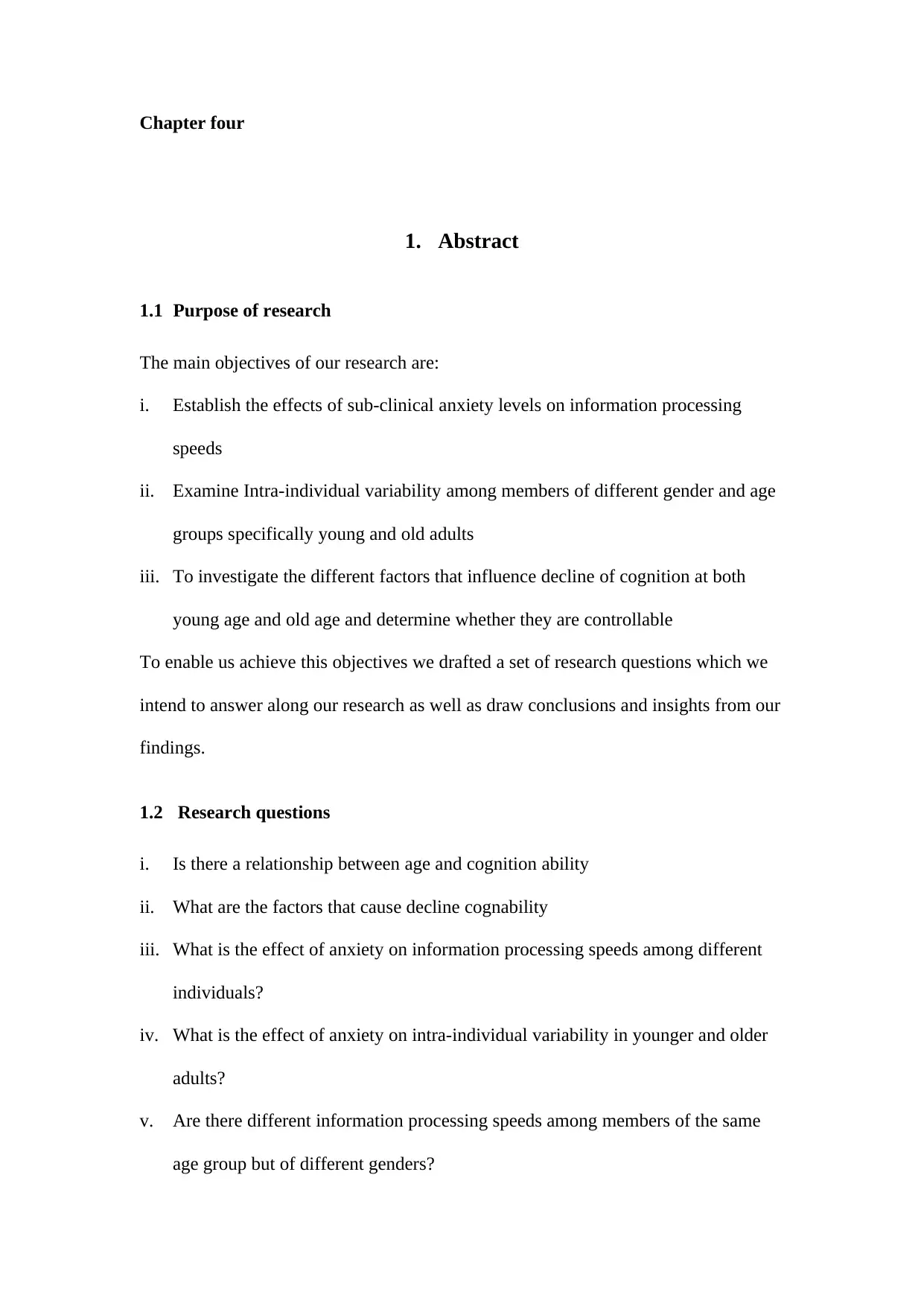
Chapter four
1. Abstract
1.1 Purpose of research
The main objectives of our research are:
i. Establish the effects of sub-clinical anxiety levels on information processing
speeds
ii. Examine Intra-individual variability among members of different gender and age
groups specifically young and old adults
iii. To investigate the different factors that influence decline of cognition at both
young age and old age and determine whether they are controllable
To enable us achieve this objectives we drafted a set of research questions which we
intend to answer along our research as well as draw conclusions and insights from our
findings.
1.2 Research questions
i. Is there a relationship between age and cognition ability
ii. What are the factors that cause decline cognability
iii. What is the effect of anxiety on information processing speeds among different
individuals?
iv. What is the effect of anxiety on intra-individual variability in younger and older
adults?
v. Are there different information processing speeds among members of the same
age group but of different genders?
1. Abstract
1.1 Purpose of research
The main objectives of our research are:
i. Establish the effects of sub-clinical anxiety levels on information processing
speeds
ii. Examine Intra-individual variability among members of different gender and age
groups specifically young and old adults
iii. To investigate the different factors that influence decline of cognition at both
young age and old age and determine whether they are controllable
To enable us achieve this objectives we drafted a set of research questions which we
intend to answer along our research as well as draw conclusions and insights from our
findings.
1.2 Research questions
i. Is there a relationship between age and cognition ability
ii. What are the factors that cause decline cognability
iii. What is the effect of anxiety on information processing speeds among different
individuals?
iv. What is the effect of anxiety on intra-individual variability in younger and older
adults?
v. Are there different information processing speeds among members of the same
age group but of different genders?
Paraphrase This Document
Need a fresh take? Get an instant paraphrase of this document with our AI Paraphraser
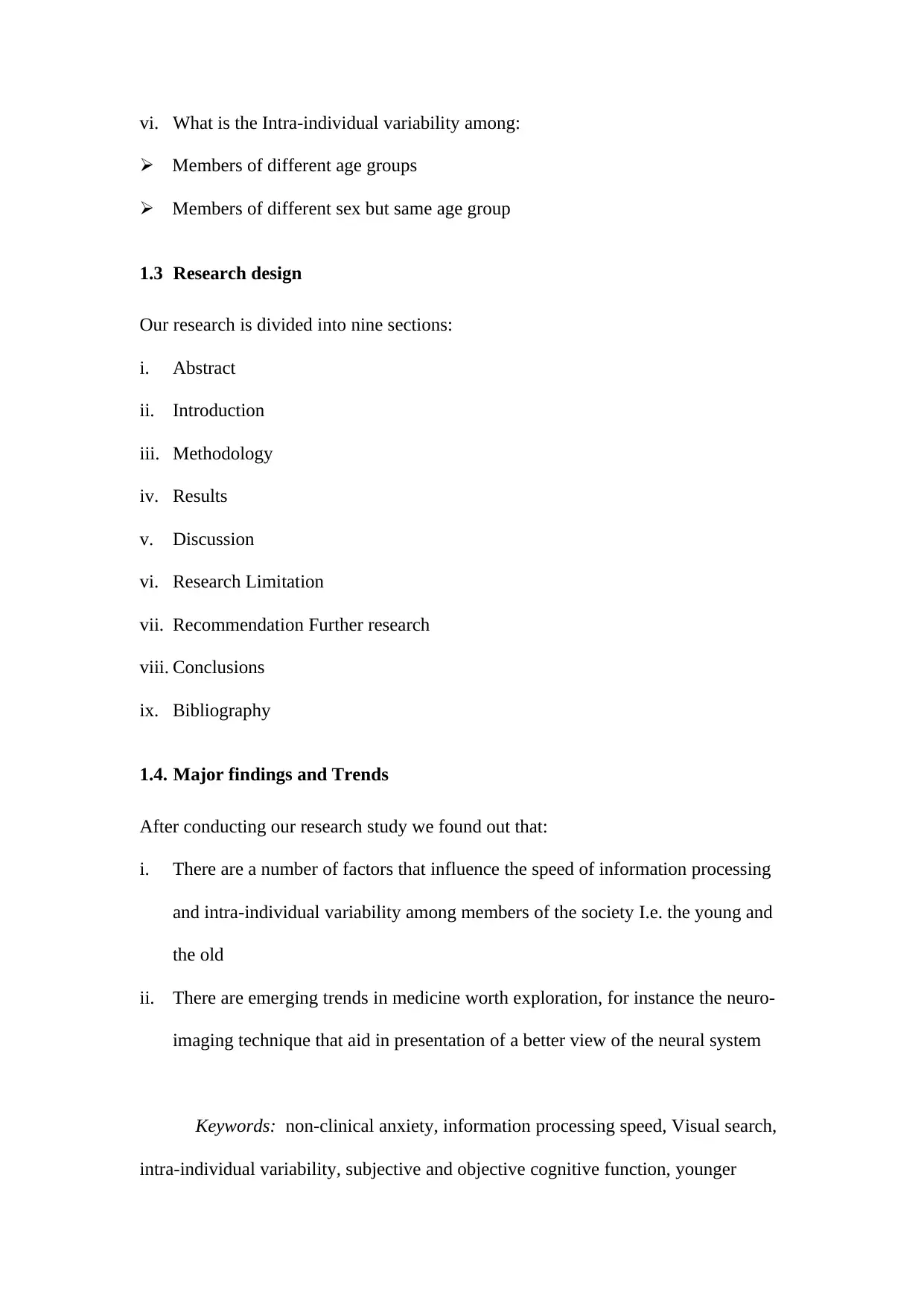
vi. What is the Intra-individual variability among:
Members of different age groups
Members of different sex but same age group
1.3 Research design
Our research is divided into nine sections:
i. Abstract
ii. Introduction
iii. Methodology
iv. Results
v. Discussion
vi. Research Limitation
vii. Recommendation Further research
viii. Conclusions
ix. Bibliography
1.4. Major findings and Trends
After conducting our research study we found out that:
i. There are a number of factors that influence the speed of information processing
and intra-individual variability among members of the society I.e. the young and
the old
ii. There are emerging trends in medicine worth exploration, for instance the neuro-
imaging technique that aid in presentation of a better view of the neural system
Keywords: non-clinical anxiety, information processing speed, Visual search,
intra-individual variability, subjective and objective cognitive function, younger
Members of different age groups
Members of different sex but same age group
1.3 Research design
Our research is divided into nine sections:
i. Abstract
ii. Introduction
iii. Methodology
iv. Results
v. Discussion
vi. Research Limitation
vii. Recommendation Further research
viii. Conclusions
ix. Bibliography
1.4. Major findings and Trends
After conducting our research study we found out that:
i. There are a number of factors that influence the speed of information processing
and intra-individual variability among members of the society I.e. the young and
the old
ii. There are emerging trends in medicine worth exploration, for instance the neuro-
imaging technique that aid in presentation of a better view of the neural system
Keywords: non-clinical anxiety, information processing speed, Visual search,
intra-individual variability, subjective and objective cognitive function, younger
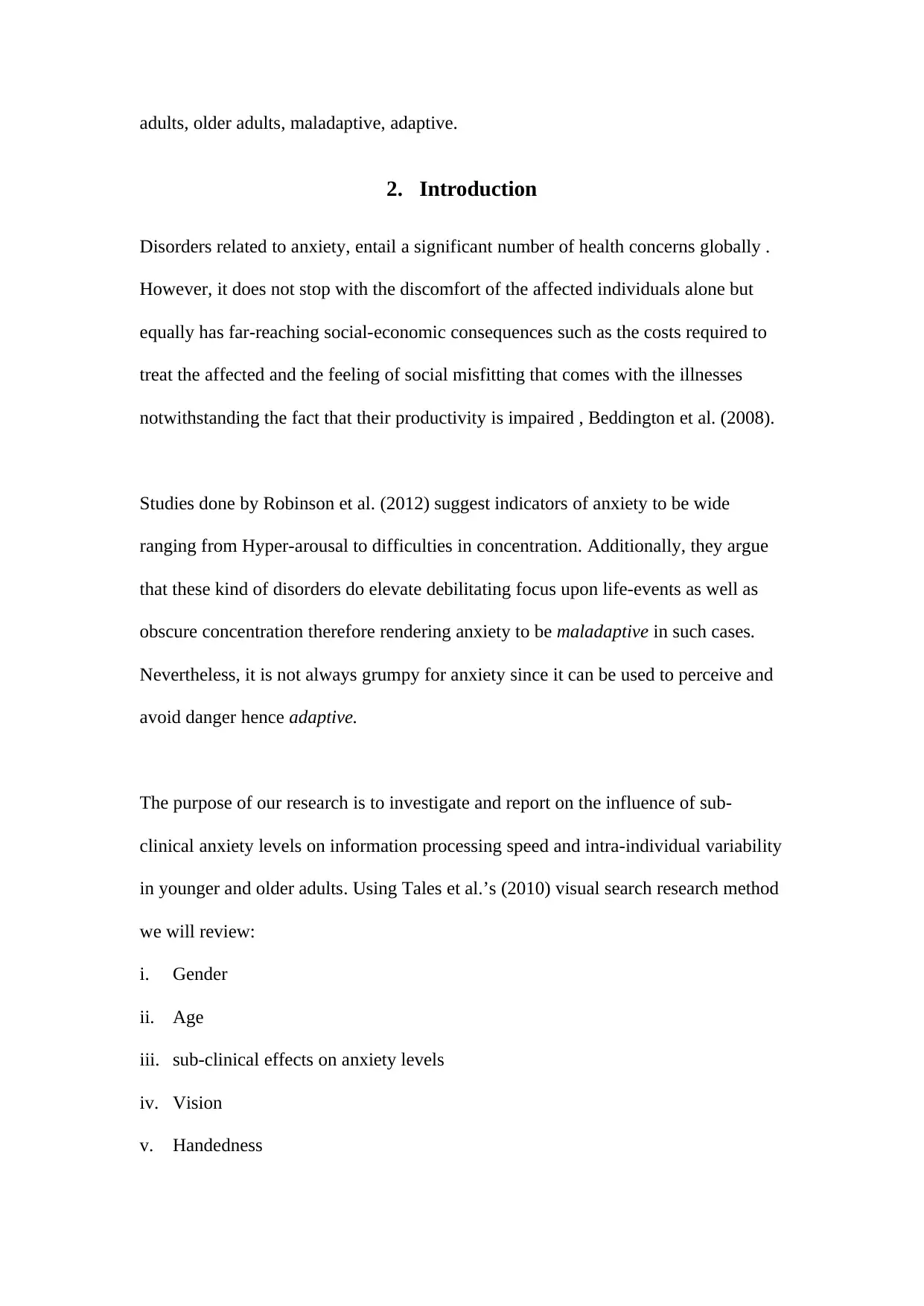
adults, older adults, maladaptive, adaptive.
2. Introduction
Disorders related to anxiety, entail a significant number of health concerns globally .
However, it does not stop with the discomfort of the affected individuals alone but
equally has far-reaching social-economic consequences such as the costs required to
treat the affected and the feeling of social misfitting that comes with the illnesses
notwithstanding the fact that their productivity is impaired , Beddington et al. (2008).
Studies done by Robinson et al. (2012) suggest indicators of anxiety to be wide
ranging from Hyper-arousal to difficulties in concentration. Additionally, they argue
that these kind of disorders do elevate debilitating focus upon life-events as well as
obscure concentration therefore rendering anxiety to be maladaptive in such cases.
Nevertheless, it is not always grumpy for anxiety since it can be used to perceive and
avoid danger hence adaptive.
The purpose of our research is to investigate and report on the influence of sub-
clinical anxiety levels on information processing speed and intra-individual variability
in younger and older adults. Using Tales et al.’s (2010) visual search research method
we will review:
i. Gender
ii. Age
iii. sub-clinical effects on anxiety levels
iv. Vision
v. Handedness
2. Introduction
Disorders related to anxiety, entail a significant number of health concerns globally .
However, it does not stop with the discomfort of the affected individuals alone but
equally has far-reaching social-economic consequences such as the costs required to
treat the affected and the feeling of social misfitting that comes with the illnesses
notwithstanding the fact that their productivity is impaired , Beddington et al. (2008).
Studies done by Robinson et al. (2012) suggest indicators of anxiety to be wide
ranging from Hyper-arousal to difficulties in concentration. Additionally, they argue
that these kind of disorders do elevate debilitating focus upon life-events as well as
obscure concentration therefore rendering anxiety to be maladaptive in such cases.
Nevertheless, it is not always grumpy for anxiety since it can be used to perceive and
avoid danger hence adaptive.
The purpose of our research is to investigate and report on the influence of sub-
clinical anxiety levels on information processing speed and intra-individual variability
in younger and older adults. Using Tales et al.’s (2010) visual search research method
we will review:
i. Gender
ii. Age
iii. sub-clinical effects on anxiety levels
iv. Vision
v. Handedness
⊘ This is a preview!⊘
Do you want full access?
Subscribe today to unlock all pages.

Trusted by 1+ million students worldwide
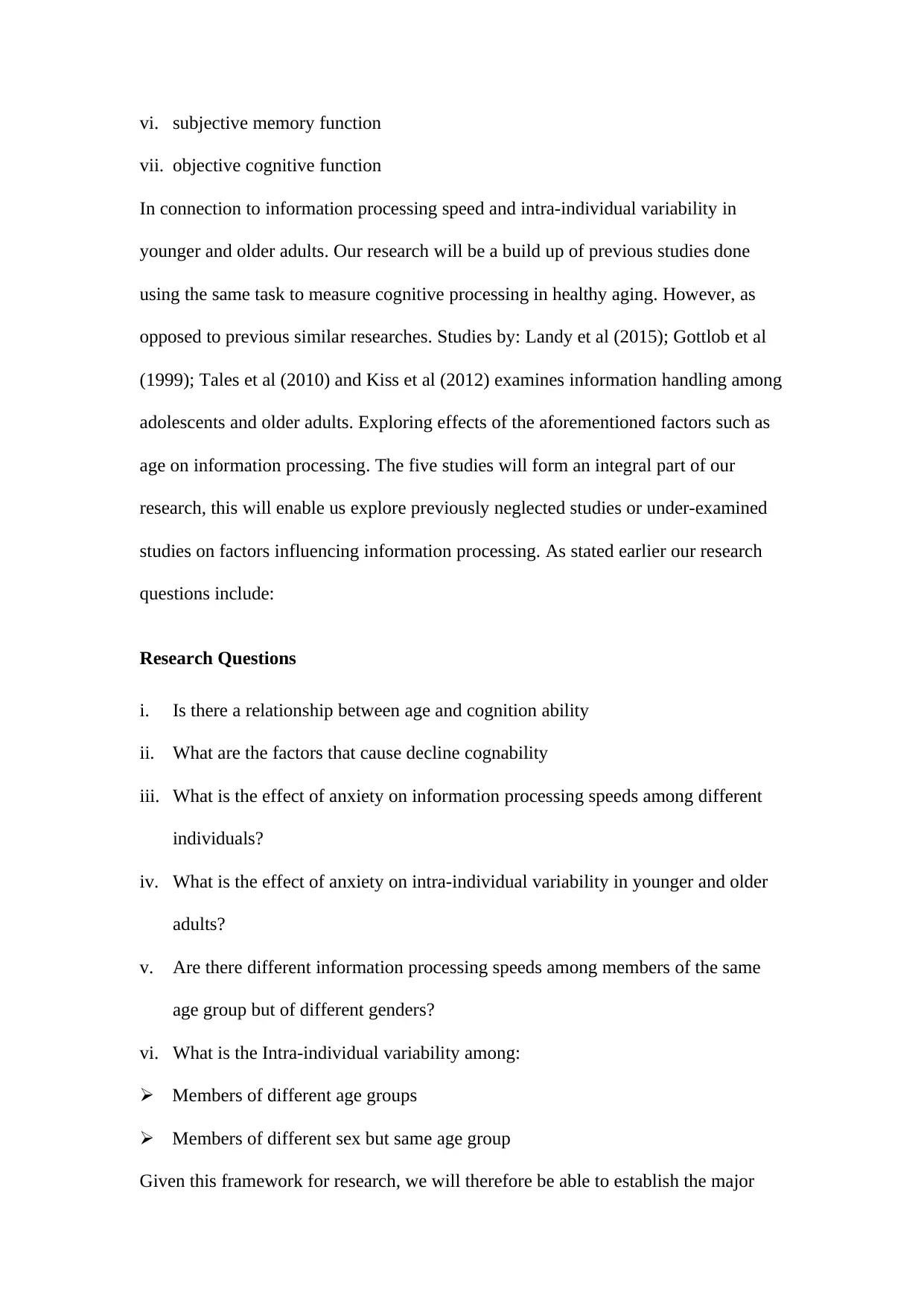
vi. subjective memory function
vii. objective cognitive function
In connection to information processing speed and intra-individual variability in
younger and older adults. Our research will be a build up of previous studies done
using the same task to measure cognitive processing in healthy aging. However, as
opposed to previous similar researches. Studies by: Landy et al (2015); Gottlob et al
(1999); Tales et al (2010) and Kiss et al (2012) examines information handling among
adolescents and older adults. Exploring effects of the aforementioned factors such as
age on information processing. The five studies will form an integral part of our
research, this will enable us explore previously neglected studies or under-examined
studies on factors influencing information processing. As stated earlier our research
questions include:
Research Questions
i. Is there a relationship between age and cognition ability
ii. What are the factors that cause decline cognability
iii. What is the effect of anxiety on information processing speeds among different
individuals?
iv. What is the effect of anxiety on intra-individual variability in younger and older
adults?
v. Are there different information processing speeds among members of the same
age group but of different genders?
vi. What is the Intra-individual variability among:
Members of different age groups
Members of different sex but same age group
Given this framework for research, we will therefore be able to establish the major
vii. objective cognitive function
In connection to information processing speed and intra-individual variability in
younger and older adults. Our research will be a build up of previous studies done
using the same task to measure cognitive processing in healthy aging. However, as
opposed to previous similar researches. Studies by: Landy et al (2015); Gottlob et al
(1999); Tales et al (2010) and Kiss et al (2012) examines information handling among
adolescents and older adults. Exploring effects of the aforementioned factors such as
age on information processing. The five studies will form an integral part of our
research, this will enable us explore previously neglected studies or under-examined
studies on factors influencing information processing. As stated earlier our research
questions include:
Research Questions
i. Is there a relationship between age and cognition ability
ii. What are the factors that cause decline cognability
iii. What is the effect of anxiety on information processing speeds among different
individuals?
iv. What is the effect of anxiety on intra-individual variability in younger and older
adults?
v. Are there different information processing speeds among members of the same
age group but of different genders?
vi. What is the Intra-individual variability among:
Members of different age groups
Members of different sex but same age group
Given this framework for research, we will therefore be able to establish the major
Paraphrase This Document
Need a fresh take? Get an instant paraphrase of this document with our AI Paraphraser
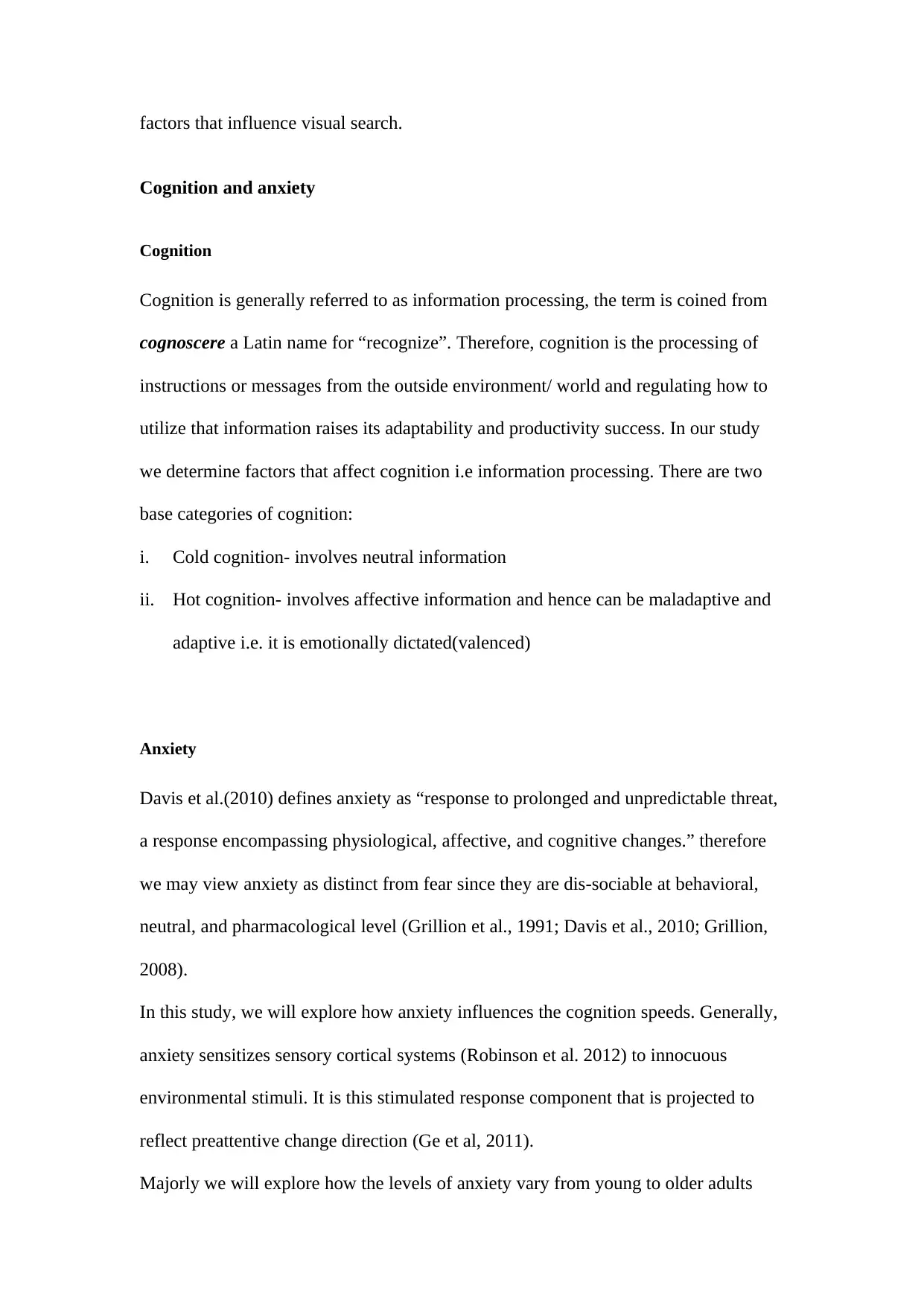
factors that influence visual search.
Cognition and anxiety
Cognition
Cognition is generally referred to as information processing, the term is coined from
cognoscere a Latin name for “recognize”. Therefore, cognition is the processing of
instructions or messages from the outside environment/ world and regulating how to
utilize that information raises its adaptability and productivity success. In our study
we determine factors that affect cognition i.e information processing. There are two
base categories of cognition:
i. Cold cognition- involves neutral information
ii. Hot cognition- involves affective information and hence can be maladaptive and
adaptive i.e. it is emotionally dictated(valenced)
Anxiety
Davis et al.(2010) defines anxiety as “response to prolonged and unpredictable threat,
a response encompassing physiological, affective, and cognitive changes.” therefore
we may view anxiety as distinct from fear since they are dis-sociable at behavioral,
neutral, and pharmacological level (Grillion et al., 1991; Davis et al., 2010; Grillion,
2008).
In this study, we will explore how anxiety influences the cognition speeds. Generally,
anxiety sensitizes sensory cortical systems (Robinson et al. 2012) to innocuous
environmental stimuli. It is this stimulated response component that is projected to
reflect preattentive change direction (Ge et al, 2011).
Majorly we will explore how the levels of anxiety vary from young to older adults
Cognition and anxiety
Cognition
Cognition is generally referred to as information processing, the term is coined from
cognoscere a Latin name for “recognize”. Therefore, cognition is the processing of
instructions or messages from the outside environment/ world and regulating how to
utilize that information raises its adaptability and productivity success. In our study
we determine factors that affect cognition i.e information processing. There are two
base categories of cognition:
i. Cold cognition- involves neutral information
ii. Hot cognition- involves affective information and hence can be maladaptive and
adaptive i.e. it is emotionally dictated(valenced)
Anxiety
Davis et al.(2010) defines anxiety as “response to prolonged and unpredictable threat,
a response encompassing physiological, affective, and cognitive changes.” therefore
we may view anxiety as distinct from fear since they are dis-sociable at behavioral,
neutral, and pharmacological level (Grillion et al., 1991; Davis et al., 2010; Grillion,
2008).
In this study, we will explore how anxiety influences the cognition speeds. Generally,
anxiety sensitizes sensory cortical systems (Robinson et al. 2012) to innocuous
environmental stimuli. It is this stimulated response component that is projected to
reflect preattentive change direction (Ge et al, 2011).
Majorly we will explore how the levels of anxiety vary from young to older adults
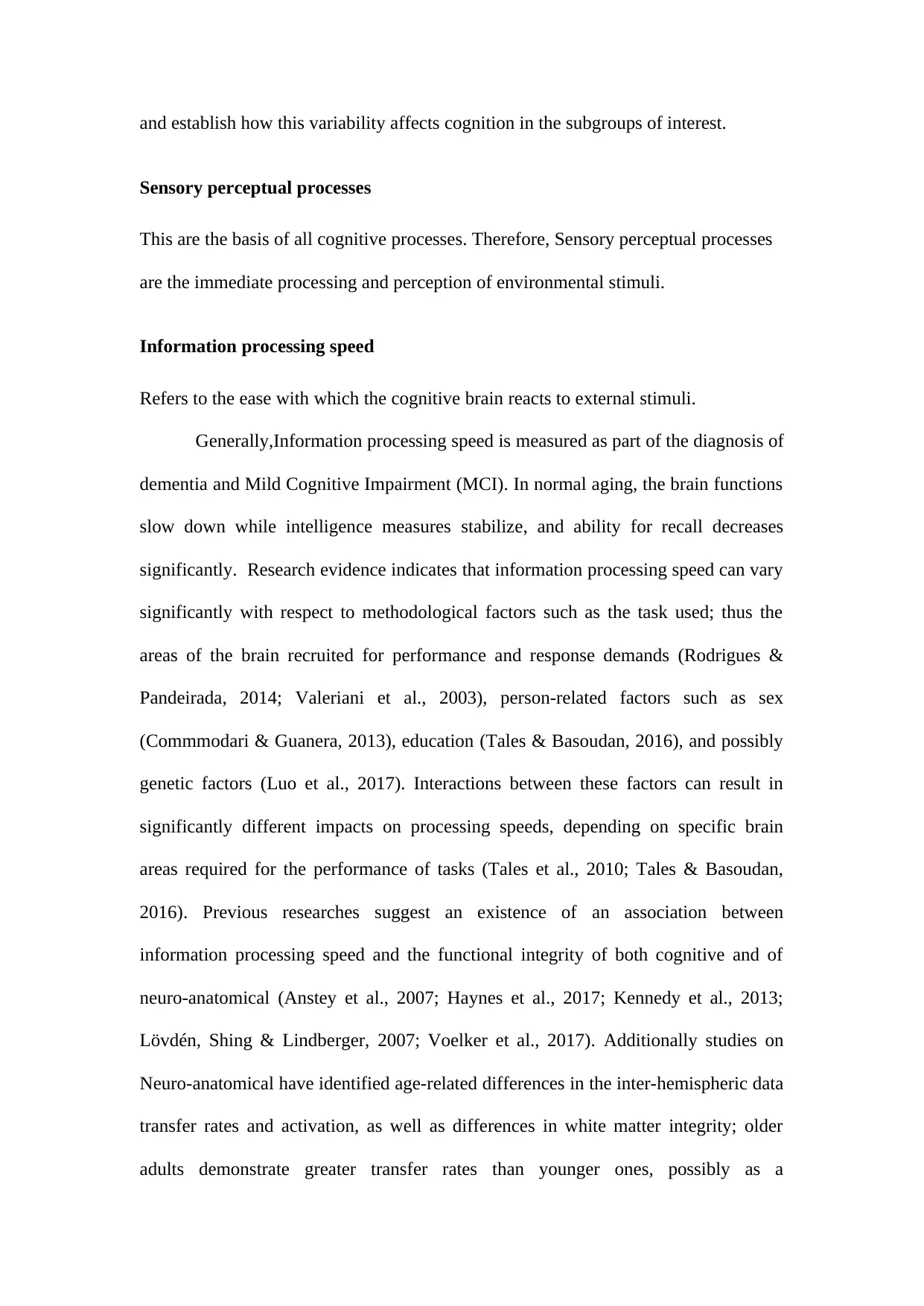
and establish how this variability affects cognition in the subgroups of interest.
Sensory perceptual processes
This are the basis of all cognitive processes. Therefore, Sensory perceptual processes
are the immediate processing and perception of environmental stimuli.
Information processing speed
Refers to the ease with which the cognitive brain reacts to external stimuli.
Generally,Information processing speed is measured as part of the diagnosis of
dementia and Mild Cognitive Impairment (MCI). In normal aging, the brain functions
slow down while intelligence measures stabilize, and ability for recall decreases
significantly. Research evidence indicates that information processing speed can vary
significantly with respect to methodological factors such as the task used; thus the
areas of the brain recruited for performance and response demands (Rodrigues &
Pandeirada, 2014; Valeriani et al., 2003), person-related factors such as sex
(Commmodari & Guanera, 2013), education (Tales & Basoudan, 2016), and possibly
genetic factors (Luo et al., 2017). Interactions between these factors can result in
significantly different impacts on processing speeds, depending on specific brain
areas required for the performance of tasks (Tales et al., 2010; Tales & Basoudan,
2016). Previous researches suggest an existence of an association between
information processing speed and the functional integrity of both cognitive and of
neuro-anatomical (Anstey et al., 2007; Haynes et al., 2017; Kennedy et al., 2013;
Lövdén, Shing & Lindberger, 2007; Voelker et al., 2017). Additionally studies on
Neuro-anatomical have identified age-related differences in the inter-hemispheric data
transfer rates and activation, as well as differences in white matter integrity; older
adults demonstrate greater transfer rates than younger ones, possibly as a
Sensory perceptual processes
This are the basis of all cognitive processes. Therefore, Sensory perceptual processes
are the immediate processing and perception of environmental stimuli.
Information processing speed
Refers to the ease with which the cognitive brain reacts to external stimuli.
Generally,Information processing speed is measured as part of the diagnosis of
dementia and Mild Cognitive Impairment (MCI). In normal aging, the brain functions
slow down while intelligence measures stabilize, and ability for recall decreases
significantly. Research evidence indicates that information processing speed can vary
significantly with respect to methodological factors such as the task used; thus the
areas of the brain recruited for performance and response demands (Rodrigues &
Pandeirada, 2014; Valeriani et al., 2003), person-related factors such as sex
(Commmodari & Guanera, 2013), education (Tales & Basoudan, 2016), and possibly
genetic factors (Luo et al., 2017). Interactions between these factors can result in
significantly different impacts on processing speeds, depending on specific brain
areas required for the performance of tasks (Tales et al., 2010; Tales & Basoudan,
2016). Previous researches suggest an existence of an association between
information processing speed and the functional integrity of both cognitive and of
neuro-anatomical (Anstey et al., 2007; Haynes et al., 2017; Kennedy et al., 2013;
Lövdén, Shing & Lindberger, 2007; Voelker et al., 2017). Additionally studies on
Neuro-anatomical have identified age-related differences in the inter-hemispheric data
transfer rates and activation, as well as differences in white matter integrity; older
adults demonstrate greater transfer rates than younger ones, possibly as a
⊘ This is a preview!⊘
Do you want full access?
Subscribe today to unlock all pages.

Trusted by 1+ million students worldwide
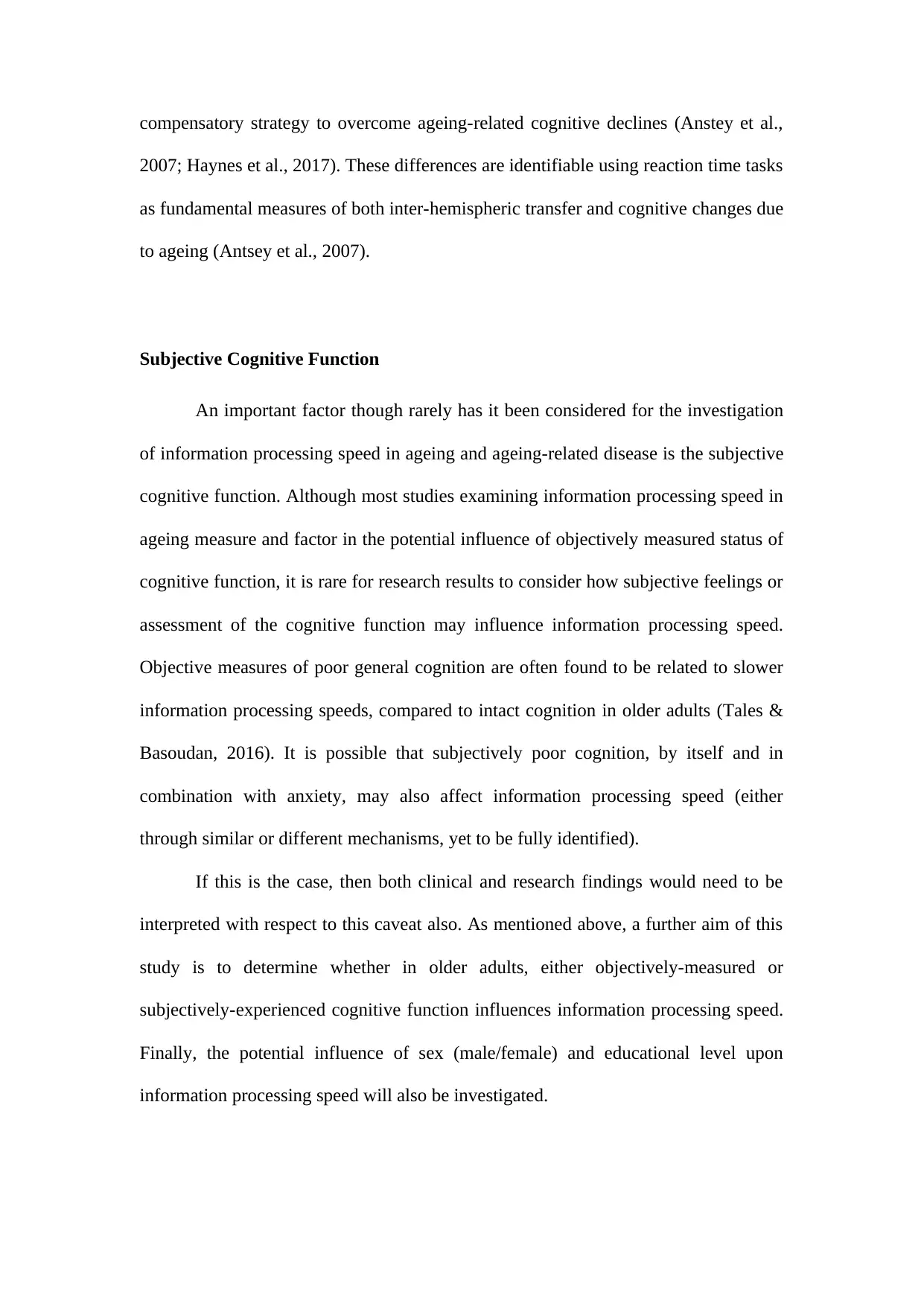
compensatory strategy to overcome ageing-related cognitive declines (Anstey et al.,
2007; Haynes et al., 2017). These differences are identifiable using reaction time tasks
as fundamental measures of both inter-hemispheric transfer and cognitive changes due
to ageing (Antsey et al., 2007).
Subjective Cognitive Function
An important factor though rarely has it been considered for the investigation
of information processing speed in ageing and ageing-related disease is the subjective
cognitive function. Although most studies examining information processing speed in
ageing measure and factor in the potential influence of objectively measured status of
cognitive function, it is rare for research results to consider how subjective feelings or
assessment of the cognitive function may influence information processing speed.
Objective measures of poor general cognition are often found to be related to slower
information processing speeds, compared to intact cognition in older adults (Tales &
Basoudan, 2016). It is possible that subjectively poor cognition, by itself and in
combination with anxiety, may also affect information processing speed (either
through similar or different mechanisms, yet to be fully identified).
If this is the case, then both clinical and research findings would need to be
interpreted with respect to this caveat also. As mentioned above, a further aim of this
study is to determine whether in older adults, either objectively-measured or
subjectively-experienced cognitive function influences information processing speed.
Finally, the potential influence of sex (male/female) and educational level upon
information processing speed will also be investigated.
2007; Haynes et al., 2017). These differences are identifiable using reaction time tasks
as fundamental measures of both inter-hemispheric transfer and cognitive changes due
to ageing (Antsey et al., 2007).
Subjective Cognitive Function
An important factor though rarely has it been considered for the investigation
of information processing speed in ageing and ageing-related disease is the subjective
cognitive function. Although most studies examining information processing speed in
ageing measure and factor in the potential influence of objectively measured status of
cognitive function, it is rare for research results to consider how subjective feelings or
assessment of the cognitive function may influence information processing speed.
Objective measures of poor general cognition are often found to be related to slower
information processing speeds, compared to intact cognition in older adults (Tales &
Basoudan, 2016). It is possible that subjectively poor cognition, by itself and in
combination with anxiety, may also affect information processing speed (either
through similar or different mechanisms, yet to be fully identified).
If this is the case, then both clinical and research findings would need to be
interpreted with respect to this caveat also. As mentioned above, a further aim of this
study is to determine whether in older adults, either objectively-measured or
subjectively-experienced cognitive function influences information processing speed.
Finally, the potential influence of sex (male/female) and educational level upon
information processing speed will also be investigated.
Paraphrase This Document
Need a fresh take? Get an instant paraphrase of this document with our AI Paraphraser
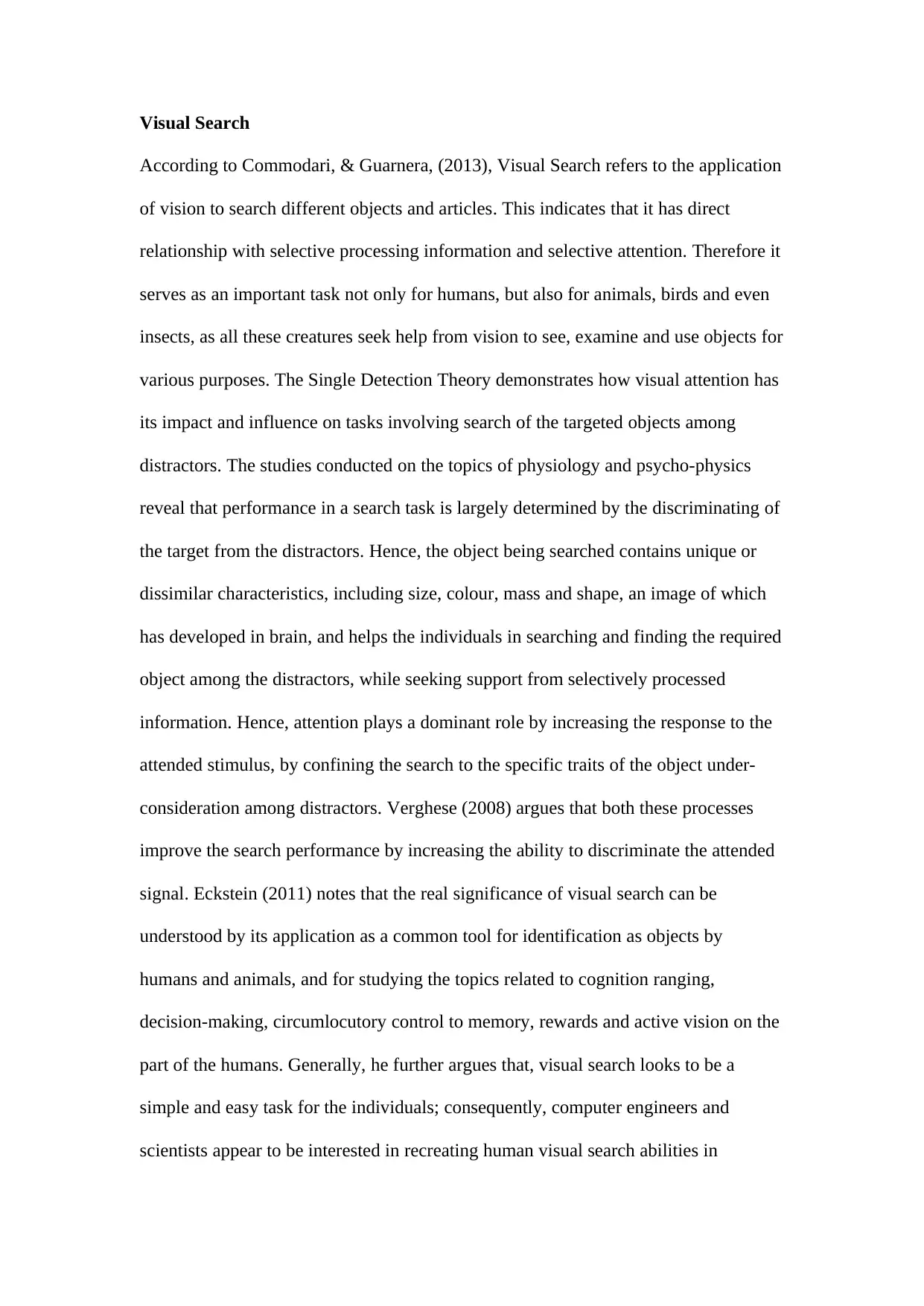
Visual Search
According to Commodari, & Guarnera, (2013), Visual Search refers to the application
of vision to search different objects and articles. This indicates that it has direct
relationship with selective processing information and selective attention. Therefore it
serves as an important task not only for humans, but also for animals, birds and even
insects, as all these creatures seek help from vision to see, examine and use objects for
various purposes. The Single Detection Theory demonstrates how visual attention has
its impact and influence on tasks involving search of the targeted objects among
distractors. The studies conducted on the topics of physiology and psycho-physics
reveal that performance in a search task is largely determined by the discriminating of
the target from the distractors. Hence, the object being searched contains unique or
dissimilar characteristics, including size, colour, mass and shape, an image of which
has developed in brain, and helps the individuals in searching and finding the required
object among the distractors, while seeking support from selectively processed
information. Hence, attention plays a dominant role by increasing the response to the
attended stimulus, by confining the search to the specific traits of the object under-
consideration among distractors. Verghese (2008) argues that both these processes
improve the search performance by increasing the ability to discriminate the attended
signal. Eckstein (2011) notes that the real significance of visual search can be
understood by its application as a common tool for identification as objects by
humans and animals, and for studying the topics related to cognition ranging,
decision-making, circumlocutory control to memory, rewards and active vision on the
part of the humans. Generally, he further argues that, visual search looks to be a
simple and easy task for the individuals; consequently, computer engineers and
scientists appear to be interested in recreating human visual search abilities in
According to Commodari, & Guarnera, (2013), Visual Search refers to the application
of vision to search different objects and articles. This indicates that it has direct
relationship with selective processing information and selective attention. Therefore it
serves as an important task not only for humans, but also for animals, birds and even
insects, as all these creatures seek help from vision to see, examine and use objects for
various purposes. The Single Detection Theory demonstrates how visual attention has
its impact and influence on tasks involving search of the targeted objects among
distractors. The studies conducted on the topics of physiology and psycho-physics
reveal that performance in a search task is largely determined by the discriminating of
the target from the distractors. Hence, the object being searched contains unique or
dissimilar characteristics, including size, colour, mass and shape, an image of which
has developed in brain, and helps the individuals in searching and finding the required
object among the distractors, while seeking support from selectively processed
information. Hence, attention plays a dominant role by increasing the response to the
attended stimulus, by confining the search to the specific traits of the object under-
consideration among distractors. Verghese (2008) argues that both these processes
improve the search performance by increasing the ability to discriminate the attended
signal. Eckstein (2011) notes that the real significance of visual search can be
understood by its application as a common tool for identification as objects by
humans and animals, and for studying the topics related to cognition ranging,
decision-making, circumlocutory control to memory, rewards and active vision on the
part of the humans. Generally, he further argues that, visual search looks to be a
simple and easy task for the individuals; consequently, computer engineers and
scientists appear to be interested in recreating human visual search abilities in
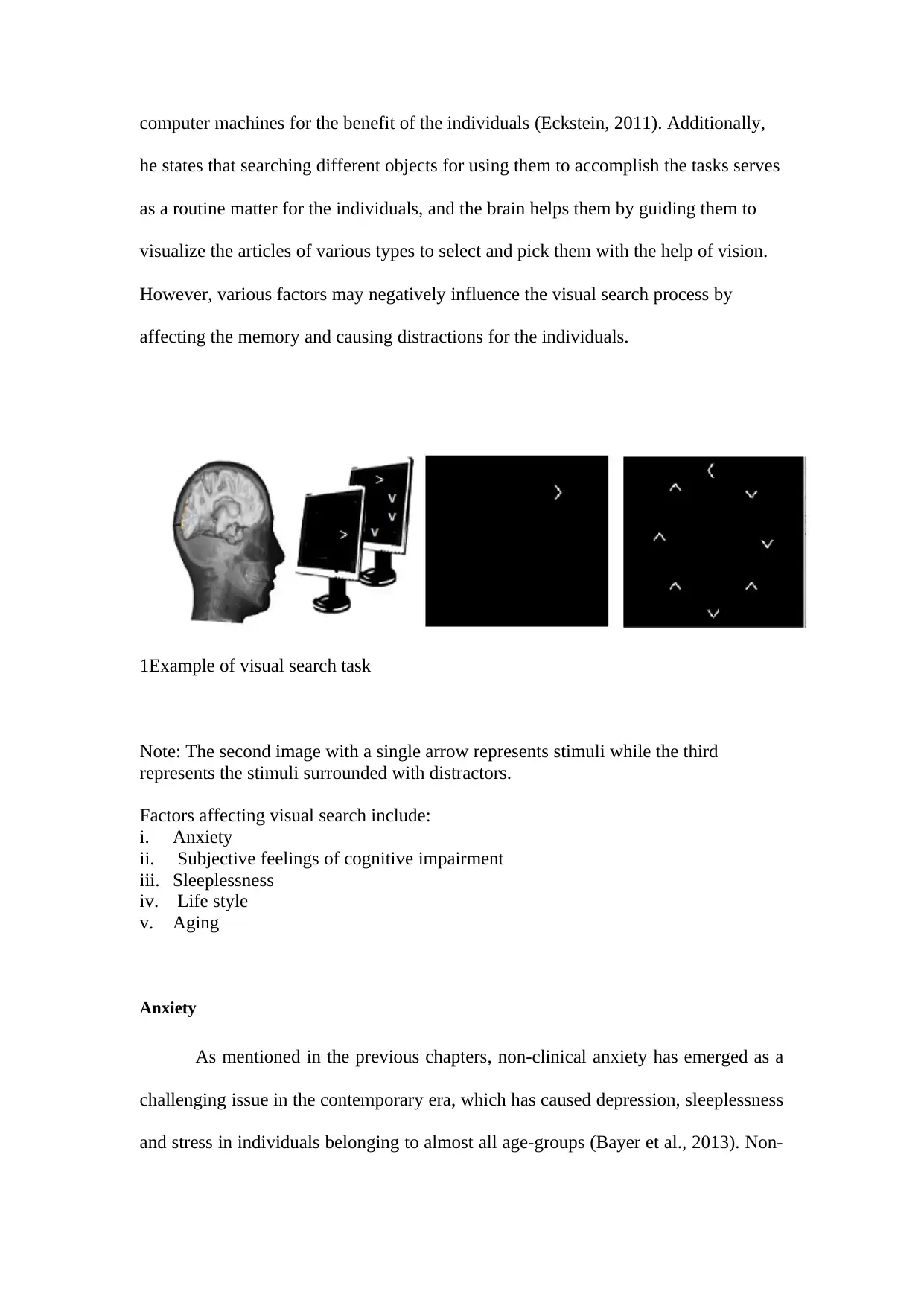
computer machines for the benefit of the individuals (Eckstein, 2011). Additionally,
he states that searching different objects for using them to accomplish the tasks serves
as a routine matter for the individuals, and the brain helps them by guiding them to
visualize the articles of various types to select and pick them with the help of vision.
However, various factors may negatively influence the visual search process by
affecting the memory and causing distractions for the individuals.
1Example of visual search task
Note: The second image with a single arrow represents stimuli while the third
represents the stimuli surrounded with distractors.
Factors affecting visual search include:
i. Anxiety
ii. Subjective feelings of cognitive impairment
iii. Sleeplessness
iv. Life style
v. Aging
Anxiety
As mentioned in the previous chapters, non-clinical anxiety has emerged as a
challenging issue in the contemporary era, which has caused depression, sleeplessness
and stress in individuals belonging to almost all age-groups (Bayer et al., 2013). Non-
he states that searching different objects for using them to accomplish the tasks serves
as a routine matter for the individuals, and the brain helps them by guiding them to
visualize the articles of various types to select and pick them with the help of vision.
However, various factors may negatively influence the visual search process by
affecting the memory and causing distractions for the individuals.
1Example of visual search task
Note: The second image with a single arrow represents stimuli while the third
represents the stimuli surrounded with distractors.
Factors affecting visual search include:
i. Anxiety
ii. Subjective feelings of cognitive impairment
iii. Sleeplessness
iv. Life style
v. Aging
Anxiety
As mentioned in the previous chapters, non-clinical anxiety has emerged as a
challenging issue in the contemporary era, which has caused depression, sleeplessness
and stress in individuals belonging to almost all age-groups (Bayer et al., 2013). Non-
⊘ This is a preview!⊘
Do you want full access?
Subscribe today to unlock all pages.

Trusted by 1+ million students worldwide
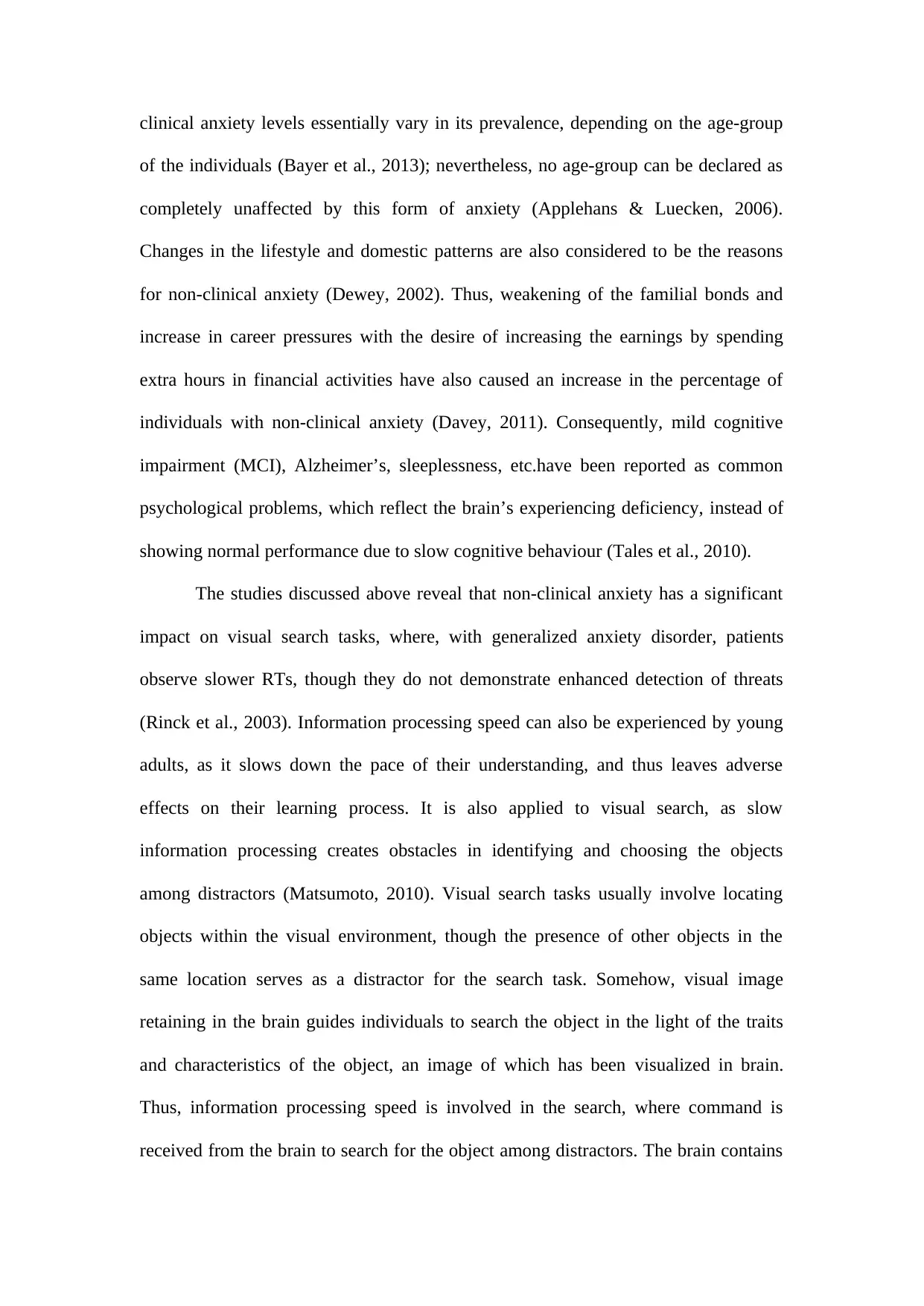
clinical anxiety levels essentially vary in its prevalence, depending on the age-group
of the individuals (Bayer et al., 2013); nevertheless, no age-group can be declared as
completely unaffected by this form of anxiety (Applehans & Luecken, 2006).
Changes in the lifestyle and domestic patterns are also considered to be the reasons
for non-clinical anxiety (Dewey, 2002). Thus, weakening of the familial bonds and
increase in career pressures with the desire of increasing the earnings by spending
extra hours in financial activities have also caused an increase in the percentage of
individuals with non-clinical anxiety (Davey, 2011). Consequently, mild cognitive
impairment (MCI), Alzheimer’s, sleeplessness, etc.have been reported as common
psychological problems, which reflect the brain’s experiencing deficiency, instead of
showing normal performance due to slow cognitive behaviour (Tales et al., 2010).
The studies discussed above reveal that non-clinical anxiety has a significant
impact on visual search tasks, where, with generalized anxiety disorder, patients
observe slower RTs, though they do not demonstrate enhanced detection of threats
(Rinck et al., 2003). Information processing speed can also be experienced by young
adults, as it slows down the pace of their understanding, and thus leaves adverse
effects on their learning process. It is also applied to visual search, as slow
information processing creates obstacles in identifying and choosing the objects
among distractors (Matsumoto, 2010). Visual search tasks usually involve locating
objects within the visual environment, though the presence of other objects in the
same location serves as a distractor for the search task. Somehow, visual image
retaining in the brain guides individuals to search the object in the light of the traits
and characteristics of the object, an image of which has been visualized in brain.
Thus, information processing speed is involved in the search, where command is
received from the brain to search for the object among distractors. The brain contains
of the individuals (Bayer et al., 2013); nevertheless, no age-group can be declared as
completely unaffected by this form of anxiety (Applehans & Luecken, 2006).
Changes in the lifestyle and domestic patterns are also considered to be the reasons
for non-clinical anxiety (Dewey, 2002). Thus, weakening of the familial bonds and
increase in career pressures with the desire of increasing the earnings by spending
extra hours in financial activities have also caused an increase in the percentage of
individuals with non-clinical anxiety (Davey, 2011). Consequently, mild cognitive
impairment (MCI), Alzheimer’s, sleeplessness, etc.have been reported as common
psychological problems, which reflect the brain’s experiencing deficiency, instead of
showing normal performance due to slow cognitive behaviour (Tales et al., 2010).
The studies discussed above reveal that non-clinical anxiety has a significant
impact on visual search tasks, where, with generalized anxiety disorder, patients
observe slower RTs, though they do not demonstrate enhanced detection of threats
(Rinck et al., 2003). Information processing speed can also be experienced by young
adults, as it slows down the pace of their understanding, and thus leaves adverse
effects on their learning process. It is also applied to visual search, as slow
information processing creates obstacles in identifying and choosing the objects
among distractors (Matsumoto, 2010). Visual search tasks usually involve locating
objects within the visual environment, though the presence of other objects in the
same location serves as a distractor for the search task. Somehow, visual image
retaining in the brain guides individuals to search the object in the light of the traits
and characteristics of the object, an image of which has been visualized in brain.
Thus, information processing speed is involved in the search, where command is
received from the brain to search for the object among distractors. The brain contains
Paraphrase This Document
Need a fresh take? Get an instant paraphrase of this document with our AI Paraphraser
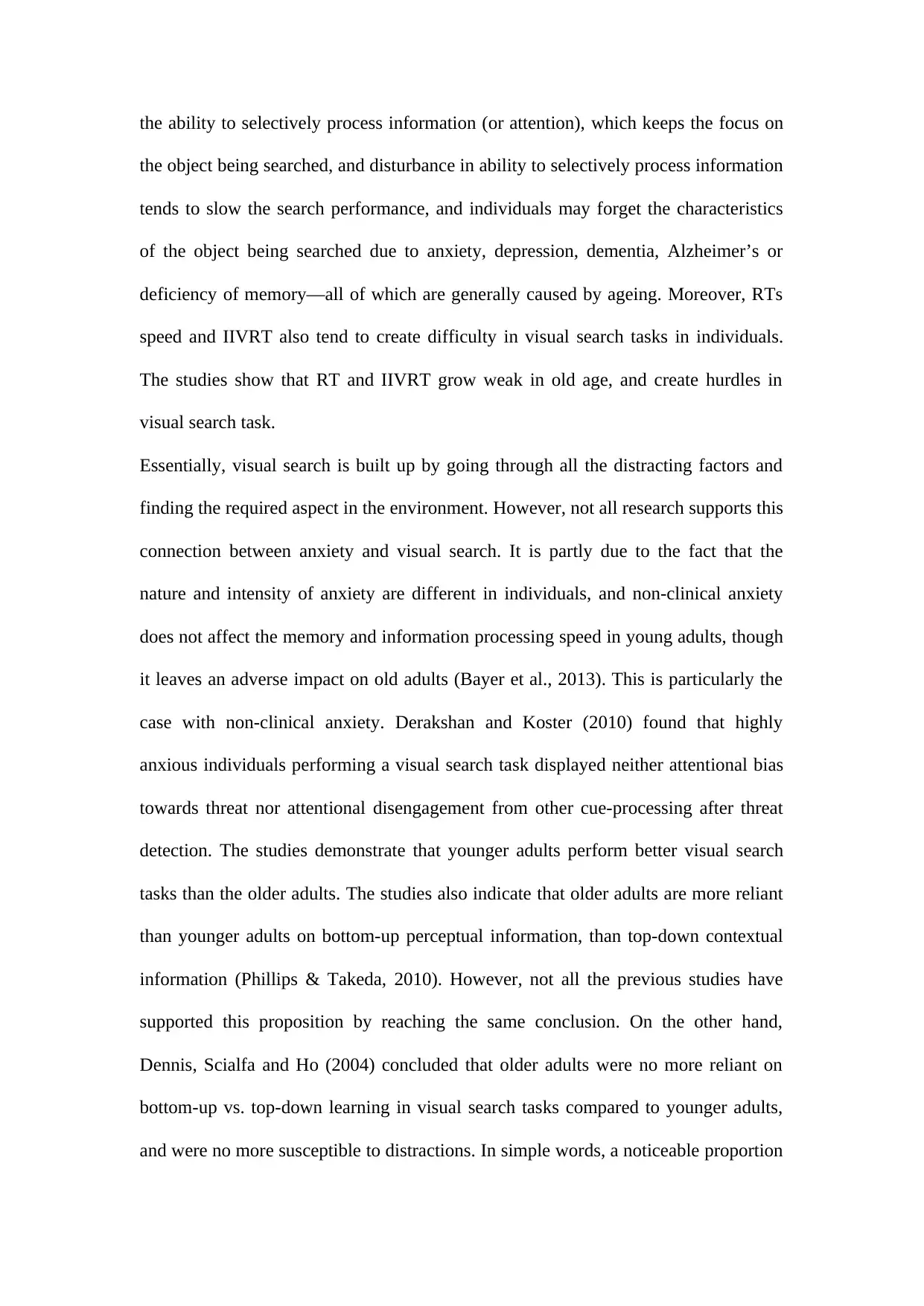
the ability to selectively process information (or attention), which keeps the focus on
the object being searched, and disturbance in ability to selectively process information
tends to slow the search performance, and individuals may forget the characteristics
of the object being searched due to anxiety, depression, dementia, Alzheimer’s or
deficiency of memory—all of which are generally caused by ageing. Moreover, RTs
speed and IIVRT also tend to create difficulty in visual search tasks in individuals.
The studies show that RT and IIVRT grow weak in old age, and create hurdles in
visual search task.
Essentially, visual search is built up by going through all the distracting factors and
finding the required aspect in the environment. However, not all research supports this
connection between anxiety and visual search. It is partly due to the fact that the
nature and intensity of anxiety are different in individuals, and non-clinical anxiety
does not affect the memory and information processing speed in young adults, though
it leaves an adverse impact on old adults (Bayer et al., 2013). This is particularly the
case with non-clinical anxiety. Derakshan and Koster (2010) found that highly
anxious individuals performing a visual search task displayed neither attentional bias
towards threat nor attentional disengagement from other cue-processing after threat
detection. The studies demonstrate that younger adults perform better visual search
tasks than the older adults. The studies also indicate that older adults are more reliant
than younger adults on bottom-up perceptual information, than top-down contextual
information (Phillips & Takeda, 2010). However, not all the previous studies have
supported this proposition by reaching the same conclusion. On the other hand,
Dennis, Scialfa and Ho (2004) concluded that older adults were no more reliant on
bottom-up vs. top-down learning in visual search tasks compared to younger adults,
and were no more susceptible to distractions. In simple words, a noticeable proportion
the object being searched, and disturbance in ability to selectively process information
tends to slow the search performance, and individuals may forget the characteristics
of the object being searched due to anxiety, depression, dementia, Alzheimer’s or
deficiency of memory—all of which are generally caused by ageing. Moreover, RTs
speed and IIVRT also tend to create difficulty in visual search tasks in individuals.
The studies show that RT and IIVRT grow weak in old age, and create hurdles in
visual search task.
Essentially, visual search is built up by going through all the distracting factors and
finding the required aspect in the environment. However, not all research supports this
connection between anxiety and visual search. It is partly due to the fact that the
nature and intensity of anxiety are different in individuals, and non-clinical anxiety
does not affect the memory and information processing speed in young adults, though
it leaves an adverse impact on old adults (Bayer et al., 2013). This is particularly the
case with non-clinical anxiety. Derakshan and Koster (2010) found that highly
anxious individuals performing a visual search task displayed neither attentional bias
towards threat nor attentional disengagement from other cue-processing after threat
detection. The studies demonstrate that younger adults perform better visual search
tasks than the older adults. The studies also indicate that older adults are more reliant
than younger adults on bottom-up perceptual information, than top-down contextual
information (Phillips & Takeda, 2010). However, not all the previous studies have
supported this proposition by reaching the same conclusion. On the other hand,
Dennis, Scialfa and Ho (2004) concluded that older adults were no more reliant on
bottom-up vs. top-down learning in visual search tasks compared to younger adults,
and were no more susceptible to distractions. In simple words, a noticeable proportion
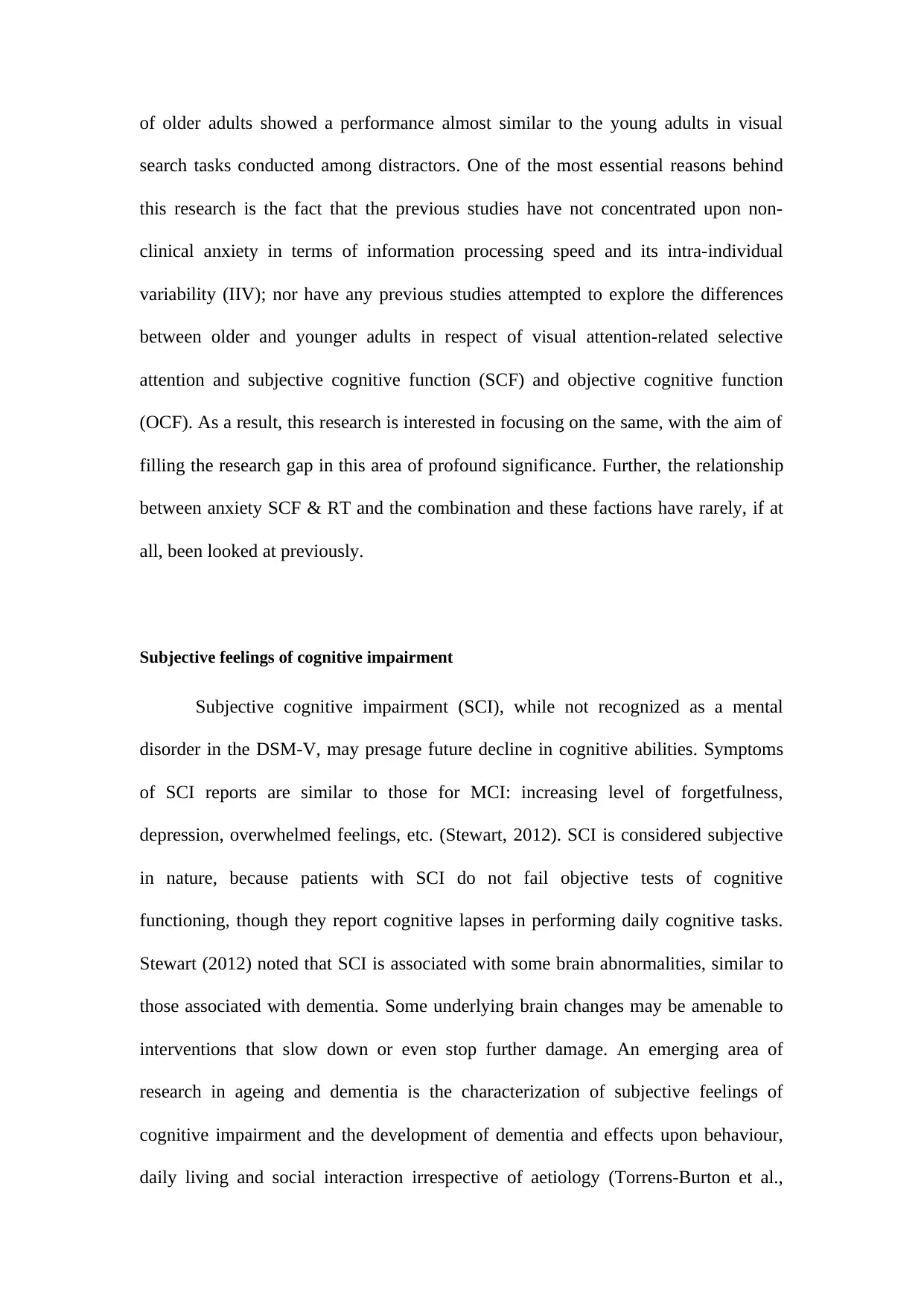
of older adults showed a performance almost similar to the young adults in visual
search tasks conducted among distractors. One of the most essential reasons behind
this research is the fact that the previous studies have not concentrated upon non-
clinical anxiety in terms of information processing speed and its intra-individual
variability (IIV); nor have any previous studies attempted to explore the differences
between older and younger adults in respect of visual attention-related selective
attention and subjective cognitive function (SCF) and objective cognitive function
(OCF). As a result, this research is interested in focusing on the same, with the aim of
filling the research gap in this area of profound significance. Further, the relationship
between anxiety SCF & RT and the combination and these factions have rarely, if at
all, been looked at previously.
Subjective feelings of cognitive impairment
Subjective cognitive impairment (SCI), while not recognized as a mental
disorder in the DSM-V, may presage future decline in cognitive abilities. Symptoms
of SCI reports are similar to those for MCI: increasing level of forgetfulness,
depression, overwhelmed feelings, etc. (Stewart, 2012). SCI is considered subjective
in nature, because patients with SCI do not fail objective tests of cognitive
functioning, though they report cognitive lapses in performing daily cognitive tasks.
Stewart (2012) noted that SCI is associated with some brain abnormalities, similar to
those associated with dementia. Some underlying brain changes may be amenable to
interventions that slow down or even stop further damage. An emerging area of
research in ageing and dementia is the characterization of subjective feelings of
cognitive impairment and the development of dementia and effects upon behaviour,
daily living and social interaction irrespective of aetiology (Torrens-Burton et al.,
search tasks conducted among distractors. One of the most essential reasons behind
this research is the fact that the previous studies have not concentrated upon non-
clinical anxiety in terms of information processing speed and its intra-individual
variability (IIV); nor have any previous studies attempted to explore the differences
between older and younger adults in respect of visual attention-related selective
attention and subjective cognitive function (SCF) and objective cognitive function
(OCF). As a result, this research is interested in focusing on the same, with the aim of
filling the research gap in this area of profound significance. Further, the relationship
between anxiety SCF & RT and the combination and these factions have rarely, if at
all, been looked at previously.
Subjective feelings of cognitive impairment
Subjective cognitive impairment (SCI), while not recognized as a mental
disorder in the DSM-V, may presage future decline in cognitive abilities. Symptoms
of SCI reports are similar to those for MCI: increasing level of forgetfulness,
depression, overwhelmed feelings, etc. (Stewart, 2012). SCI is considered subjective
in nature, because patients with SCI do not fail objective tests of cognitive
functioning, though they report cognitive lapses in performing daily cognitive tasks.
Stewart (2012) noted that SCI is associated with some brain abnormalities, similar to
those associated with dementia. Some underlying brain changes may be amenable to
interventions that slow down or even stop further damage. An emerging area of
research in ageing and dementia is the characterization of subjective feelings of
cognitive impairment and the development of dementia and effects upon behaviour,
daily living and social interaction irrespective of aetiology (Torrens-Burton et al.,
⊘ This is a preview!⊘
Do you want full access?
Subscribe today to unlock all pages.

Trusted by 1+ million students worldwide
1 out of 39
Related Documents
Your All-in-One AI-Powered Toolkit for Academic Success.
+13062052269
info@desklib.com
Available 24*7 on WhatsApp / Email
![[object Object]](/_next/static/media/star-bottom.7253800d.svg)
Unlock your academic potential
Copyright © 2020–2025 A2Z Services. All Rights Reserved. Developed and managed by ZUCOL.





